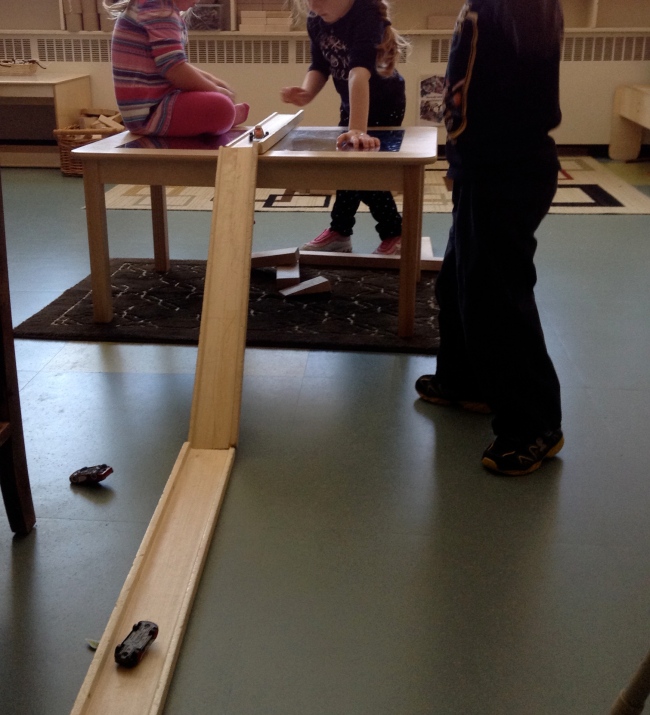This week I came outside and was immediately drawn to what “N” was doing. I could hear him before I could see him. He had discovered that if he took a chunk of ice and hit it hard against the metal pole, that not only would it make a sound but that the sound would sustain for several seconds afterwards. He has a quizzical look on his face as he tried it again and again. I’m translating our conversation from French so I apologize for any awkwardness in the phrasing.
“N”: bing…
ECE: It continues (the sound) for a long time.
“N” and friends “I” and “B”: bing, bing, bing, bing.

ECE: It’s like church bells.
Me: How long will it last, “N”, if you hit it and leave it alone? Can you count?
“I” leans against the pole and “N” hits it again.
Me: Oh, but is it different when “I” doesn’t lean against the pole?
We went through a few trials of “N” hitting the pole and “I” touching it before we got one when the sound dispersed on its own. I wondered if “I” was interested in the feeling of the vibration.
Me: 1 – 2 – 3….
“N”: Four… four seconds!
At this point, “B” and “I” join in again hitting the pole with their own chunks of ice. Bing, bing, bing…
Me: Do you think the sound will be shorter when “B” is touching it? Why would the sound be shorter when someone touches the pole?
“N”: Because it’s not hard.
Me: Because it’s not hard if someone is touching it? If someone touches the pole and the sound it shorter – why is that?
“N”: (with that quizzical look) Because the ice is harder.
Me: The ice is harder?
ECE: Look “I” – touch the pole, put your hand here.
“N” (speaking to “I” and taking his hand to place it on the pole): You do like this (hand on the pole), I do like this (hitting the pole).
Bing, bing, bing…
Me: Does the sound last longer when no one is touching it?
“N”: 1 – 2… two.
Me: Just two when someone’s touching? And why is that? Why doesn’t the sound last as long when someone’s touching it?
“N”: bing, bing, bing
ECE (placing her hand on the pole and moving in closer to “N”): What happens to the sound when “I” touches the pole? Why doesn’t it last as long?

“N”: The hands stop the sound from moving.
Me: The hands stop the sound from moving… wow.
ECE: Wow…
This was an amazing moment. We knew that “N” could get there, that if he had enough time to puzzle it out he could come up with a hypothesis that fit with his observations, both auditory and tactile. His initial hypotheses that the ice and the pole became harder didn’t seem to satisfy him any more than they satisfied us. We’ve had many opportunities for sound-making outside with found-sound instruments attached to our fence (pots, pans, metal and wood pieces, etc…) but this is the first time I’ve observed that experimentation leading to meaty inquiry questions.
Where will we go with this? We’re going to show this video to the whole class this week and present them with more opportunities to play with sounds and vibrations. While we usually teach our own music in the classroom with singing and small rhythm instruments, I think that this new thread will prompt us to visit the music room so that the students can experience bigger and more vibratory instruments. I can’t wait! Bring on the noise!








